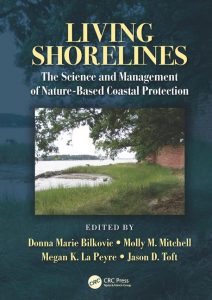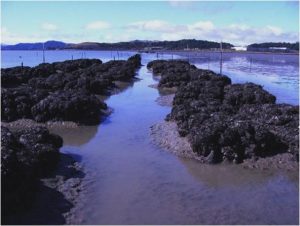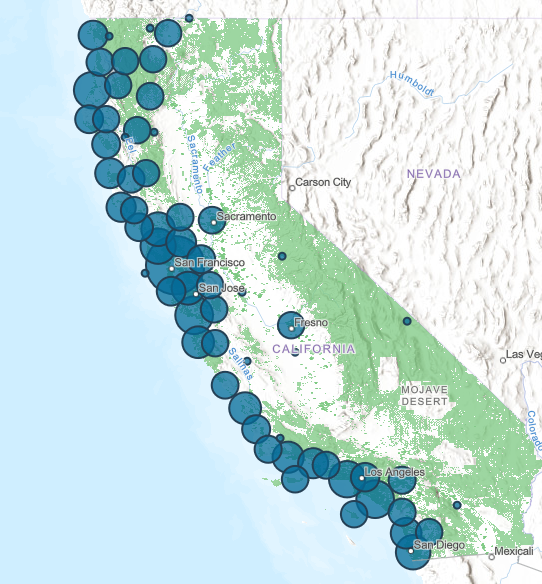News Release: Bay Area Project Pioneers Climate Resilience Strategy in New Book, “Living Shorelines”
Oakland, CA – The work of a team of Bay Area scientists led by San Francisco State and the California State Coastal Conservancy is featured in a new book, “Living Shorelines: The Science and Management of Nature-Based Coastal Protection.” The book is the first of its kind to compile, synthesize and interpret the science and practice of nature-based shoreline protection, an emerging approach to adapting to sea level rise and climate change.
“Living Shorelines” presents case studies of successful nature-based shoreline protection programs from around the globe, including two Bay Area projects to reintroduce native oysters and eelgrass to the San Rafael and Hayward shorelines. Not only do these projects restore critical native species to the area, they are also generating valuable data on the physical benefits of building biological reefs along the shoreline.
“Our  work in the Bay is a terrific example of Living Shoreline concepts put into practice.” said Katharyn Boyer, Professor of Biology at San Francisco State University’s Romberg Tiburon Center for Environmental Studies and the projects’ science lead, “In our book chapter, we explain the importance of the data we’re collecting for maintaining healthy subtidal habitats and we give clear, practical instructions for creating a sustainable Living Shoreline. We’re delighted to be included in this book, which encompasses the forefront of Living Shoreline science and hopefully lays the groundwork for future projects to follow.” SF State’s Romberg Tiburon Center is a Bay Area leader in educating the next generation of wetland scientists through pioneering research, exemplified by the innovative, nature-based solutions featured in this book.
work in the Bay is a terrific example of Living Shoreline concepts put into practice.” said Katharyn Boyer, Professor of Biology at San Francisco State University’s Romberg Tiburon Center for Environmental Studies and the projects’ science lead, “In our book chapter, we explain the importance of the data we’re collecting for maintaining healthy subtidal habitats and we give clear, practical instructions for creating a sustainable Living Shoreline. We’re delighted to be included in this book, which encompasses the forefront of Living Shoreline science and hopefully lays the groundwork for future projects to follow.” SF State’s Romberg Tiburon Center is a Bay Area leader in educating the next generation of wetland scientists through pioneering research, exemplified by the innovative, nature-based solutions featured in this book.
Living Shoreline projects use bank stabilization and habitat restoration techniques to reinforce the shoreline, minimize coastal erosion and maintain coastal ecosystems while protecting and restoring natural habitats for fish and aquatic plants and wildlife. The term “Living Shorelines” was coined because the approach provides living space for plants and animals as an integral part of coastal protection. The California Climate Adaptation Strategy recommends the use of Living Shorelines as a potential adaption method to reduce the need for engineered hard shoreline protection methods like seawalls, and to enhance shoreline habitats for marine life. The State Coastal Conservancy’s Climate Ready Program is leading Living Shorelines projects to reduce erosion and trap sediment, allowing for the buffering of tidal wetlands to increase the resiliency of the estuarine habitat.
“Living Shorelines are an innovative new approach to climate adaptation and shoreline management.” explained Marilyn Latta, Project Manager for the California State Coastal Conservancy, which is the lead agency on the Living Shorelines Project. “In San Francisco Bay we planted eelgrass and deployed artificial reefs for native oysters which provide habitat as well as food for a variety of fish and bird species. It’s revitalized the coastal ecosystem, brought new seabirds and wildlife to these areas, and we are testing concepts that can be scaled up to protect communities from sea level rise by creating a natural buffer between land and sea. I hope that our inclusion in this book will show readers that Living Shorelines are beneficial in many diverse coastal environments, even one as heavily utilized as the Bay. ”
“Living Shorelines: The Science and Management of Nature-Based Coastal Protection” provides coastal communities with the scientific foundation and practical guidance necessary to implement effective shoreline management that enhances ecosystems and coastal resilience now and into the future. The book will serve as a valuable reference to guide scientists, students, managers, planners, regulators, environmental and engineering consultants, and others engaged in the design and implementation of living shorelines. It was edited by Donna Marie Bilkovic, Molly M. Mitchell, Megan K. La Peyre, Jason D. Toft and published by CRC Press.
Contact: Taylor Samuelson, 510-286-4182, taylor.samuelson@scc.ca.gov

Latest News
- Job Posting: Deputy Executive Officer C. E. A.“Love the California Coast, the environment, supervising people, and public agency management? This might be the job for you!” The State Coastal Conservancy is seeking an experienced leader to join our Executive Management team as the Deputy Executive Officer, CEA, range A. Reporting to and assisting the Executive Officer, the Deputy Executive Officer develops and […] (Read more on Job Posting: Deputy...)
- Press Release: State, Regional Agencies Join Forces to Prepare Bay Area for Sea Level Rise, Increased FloodingMemorandum Marks Commitment to Coordinated Efforts SAN FRANCISCO, July 22, 2024… Seven regional and state public agencies have executed a new memorandum of understanding committing each agency to a joint work program to address increased threats of flooding and sea level rise in the nine-county San Francisco Bay Area region. The agencies participating in the […] (Read more on Press Release: State,...)
- San Francisco Bay Area Water Trail Implementation Meeting #42 – June 21, 2024, 10am – 12pmAGENDA June 21 , 2024 10:00 a.m. – 12:00 p.m. VIRTUAL MEETING Zoom Meeting Information: Please join us on Zoom at this link: https://scc-ca-gov.zoom.us/meeting/register/tZEtcumrqTMrHdeYKO2888Cqs7e8id82p4VD Desired Outcomes of Meeting: Attendees are informed of Water Trail-related activities, progress, and accomplishments Attendees are informed about a new water access audio tour from guest speaker Attendees are informed of […] (Read more on San Francisco Bay...)

 Help Save Sea Otters at Tax Time
Help Save Sea Otters at Tax Time

